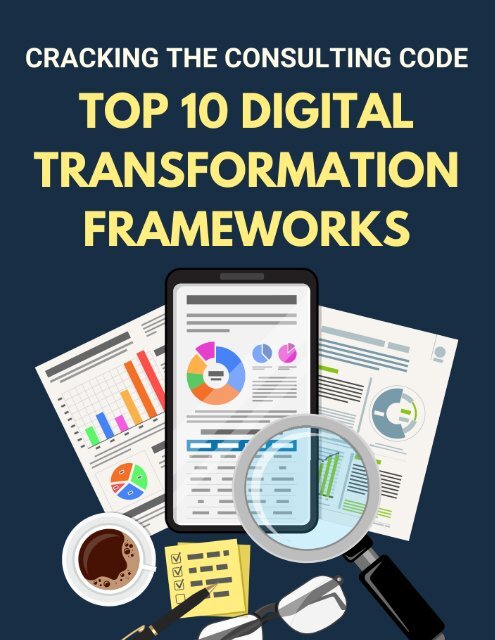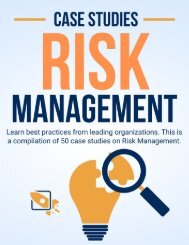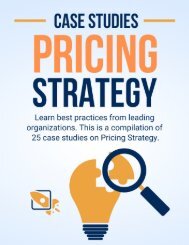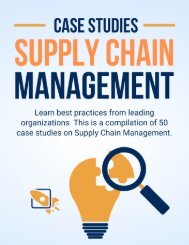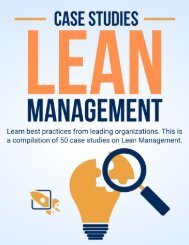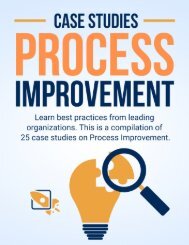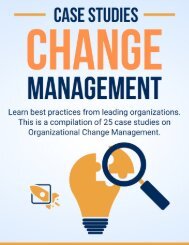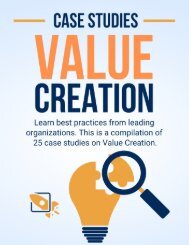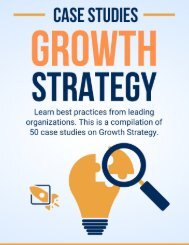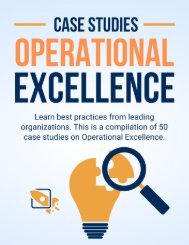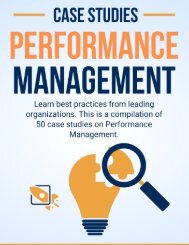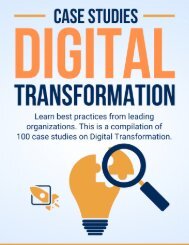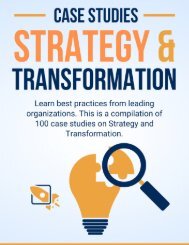Cracking the Consulting Code: Top 10 Digital Transformation Frameworks
Business frameworks and methodologies are structured tools to approach complex, but common business challenges. They allow us to cut through noise, zero in on the key issues, and facilitate the development of insightful recommendations. The importance and usefulness of business frameworks in the consulting world—especially among the global strategy firms—cannot be overstated. For consulting firms, these frameworks (https://flevy.com/top-100/consulting) are part of the bread and butter that enable them to consistently deliver value to client organizations across industries and geographies. Frameworks are helpful for several reasons: • They provide structured and detailed process for addressing the business challenge at hand. • They help ensure that the analysis is comprehensive and that critical aspects of a problem are thoroughly examined. • They accelerate the problem-solving process, as they allow consultants to apply proven methods and best practices, rather than reinventing the wheel each time or wasting time and effort pursuing dead ends. Consulting firms with extensive resources pioneer their own consulting frameworks through a combination of research, years of accumulated project experience, as well as subject matter expertise gathered from working across different sectors and functional areas. This development process is iterative and ongoing, with frameworks being continuously refined and updated to reflect new business realities and emerging best practices. Each global consulting firm maintains an internal knowledge management library of consulting framework presentations. At FlevyPro (https://flevy.com/pro), our team of former McKinsey and Big 4 consultants with several decades of combined experience have developed the largest publicly available knowledge base of consulting framework presentations, known as the FlevyPro Library. Each FlevyPro consulting framework presentation follows the standard “headline-body-bumper” design structure that is utilized by all the global strategy consulting firms. FlevyPro is currently used by 100s of consultants and business executives. Based on sales and downloads of the FlevyPro frameworks, here is what we found to be the top 10 Digital Transformation frameworks used by management consultants.
Business frameworks and methodologies are structured tools to approach complex, but common business challenges. They allow us to cut through noise, zero in on the key issues, and facilitate the development of insightful recommendations.
The importance and usefulness of business frameworks in the consulting world—especially among the global strategy firms—cannot be overstated. For consulting firms, these frameworks (https://flevy.com/top-100/consulting) are part of the bread and butter that enable them to consistently deliver value to client organizations across industries and geographies.
Frameworks are helpful for several reasons:
• They provide structured and detailed process for addressing the business challenge at hand.
• They help ensure that the analysis is comprehensive and that critical aspects of a problem are thoroughly examined.
• They accelerate the problem-solving process, as they allow consultants to apply proven methods and best practices, rather than reinventing the wheel each time or wasting time and effort pursuing dead ends.
Consulting firms with extensive resources pioneer their own consulting frameworks through a combination of research, years of accumulated project experience, as well as subject matter expertise gathered from working across different sectors and functional areas. This development process is iterative and ongoing, with frameworks being continuously refined and updated to reflect new business realities and emerging best practices. Each global consulting firm maintains an internal knowledge management library of consulting framework presentations.
At FlevyPro (https://flevy.com/pro), our team of former McKinsey and Big 4 consultants with several decades of combined experience have developed the largest publicly available knowledge base of consulting framework presentations, known as the FlevyPro Library. Each FlevyPro consulting framework presentation follows the standard “headline-body-bumper” design structure that is utilized by all the global strategy consulting firms.
FlevyPro is currently used by 100s of consultants and business executives. Based on sales and downloads of the FlevyPro frameworks, here is what we found to be the top 10 Digital Transformation frameworks used by management consultants.
You also want an ePaper? Increase the reach of your titles
YUMPU automatically turns print PDFs into web optimized ePapers that Google loves.
Flevy Management Insights 1<br />
https://flevy.com<br />
© 2024 Copyright. Flevy LLC. All rights reserved. No part of this book may be reproduced in any form or by any electronic or<br />
mechanical means, including information storage and retrieval systems, without written permission from Flevy.
Business frameworks and methodologies are structured tools to approach complex, but<br />
common business challenges. They allow us to cut through noise, zero in on <strong>the</strong> key issues, and<br />
facilitate <strong>the</strong> development of insightful recommendations.<br />
The importance and usefulness of business frameworks in <strong>the</strong> consulting world—especially<br />
among <strong>the</strong> global strategy firms—cannot be overstated. For consulting firms, <strong>the</strong>se frameworks<br />
are part of <strong>the</strong> bread and butter that enable <strong>the</strong>m to consistently deliver value to client<br />
organizations across industries and geographies.<br />
<strong>Frameworks</strong> are helpful for several reasons:<br />
• They provide structured and detailed process for addressing <strong>the</strong> business challenge at<br />
hand.<br />
• They help ensure that <strong>the</strong> analysis is comprehensive and that critical aspects of a<br />
problem are thoroughly examined.<br />
• They accelerate <strong>the</strong> problem-solving process, as <strong>the</strong>y allow consultants to apply proven<br />
methods and best practices, ra<strong>the</strong>r than reinventing <strong>the</strong> wheel each time or wasting<br />
time and effort pursuing dead ends.<br />
<strong>Consulting</strong> firms with extensive resources pioneer <strong>the</strong>ir own consulting frameworks through a<br />
combination of research, years of accumulated project experience, as well as subject matter<br />
expertise ga<strong>the</strong>red from working across different sectors and functional areas. This<br />
development process is iterative and ongoing, with frameworks being continuously refined and<br />
updated to reflect new business realities and emerging best practices. Each global consulting<br />
firm maintains an internal knowledge management library of consulting framework<br />
presentations.<br />
At FlevyPro, our team of former McKinsey and Big 4 consultants with several decades of<br />
combined experience have developed <strong>the</strong> largest publicly available knowledge base of<br />
consulting framework presentations, known as <strong>the</strong> FlevyPro Library. Each FlevyPro consulting<br />
framework presentation follows <strong>the</strong> standard “headline-body-bumper” design structure that is<br />
utilized by all <strong>the</strong> global strategy consulting firms.<br />
FlevyPro is currently used by <strong>10</strong>0s of consultants and business executives. Based on sales and<br />
downloads of <strong>the</strong> FlevyPro frameworks, here is what we found to be <strong>the</strong> top <strong>10</strong> <strong>Digital</strong><br />
<strong>Transformation</strong> frameworks used by management consultants.<br />
Flevy Management Insights 2<br />
https://flevy.com<br />
© 2024 Copyright. Flevy LLC. All rights reserved. No part of this book may be reproduced in any form or by any electronic or<br />
mechanical means, including information storage and retrieval systems, without written permission from Flevy.
Table of Contents<br />
1. Fundamentals ChatGPT & Prompt Engineering ......................................................................... 4<br />
2. Artificial Intelligence Strategy ........................................................................................................ 6<br />
3. <strong>Digital</strong> <strong>Transformation</strong> Governance ............................................................................................. 8<br />
4. <strong>Digital</strong> <strong>Transformation</strong>: Value Creation & Analysis ..................................................................<strong>10</strong><br />
5. <strong>Digital</strong> <strong>Transformation</strong> Strategy (Primer) ..................................................................................12<br />
6. Pathways to Data Monetization ..................................................................................................14<br />
7. Artificial Intelligence Strategy: <strong>Top</strong> Priorities ............................................................................16<br />
8. Robotic Process Automation (RPA).............................................................................................18<br />
9. <strong>Digital</strong> Organization Design .........................................................................................................20<br />
<strong>10</strong>. <strong>Digital</strong> Platform Strategy ............................................................................................................22<br />
Additional <strong>Consulting</strong> Tools for <strong>Digital</strong> <strong>Transformation</strong> ..............................................................24<br />
Flevy Management Insights 3<br />
https://flevy.com<br />
© 2024 Copyright. Flevy LLC. All rights reserved. No part of this book may be reproduced in any form or by any electronic or<br />
mechanical means, including information storage and retrieval systems, without written permission from Flevy.
1. Fundamentals ChatGPT & Prompt Engineering<br />
As <strong>the</strong> fastest growing app of all time, it may come as no surprise that a consulting framework<br />
presentation on ChatGPT took first place. This introduction to ChatGPT & Prompt<br />
Engineering presentation provides a comprehensive primer on <strong>the</strong> ChatGPT technology,<br />
developed by OpenAI, which stands for Generative Pre-trained Transformer. It's designed to<br />
offer foundational knowledge on how ChatGPT operates, its capabilities, and <strong>the</strong> art of Prompt<br />
Engineering—essentially how to effectively communicate with <strong>the</strong> model to achieve desired<br />
outcomes.<br />
This framework covers <strong>the</strong> mechanics behind GPT models, introduces ChatGPT and its user<br />
interface, discusses limitations and ethical considerations, and offers in-depth guidance on<br />
Prompt Engineering with practical examples across various applications.<br />
This framework is utilized primarily in educational and practical contexts to enhance<br />
understanding and application of ChatGPT in business settings. It's especially relevant for midsize<br />
to large organizations looking to leverage AI for automating customer service, enhancing<br />
decision-making processes, or improving efficiency in various tasks. By following this<br />
framework, users can:<br />
• Understand <strong>the</strong> underlying technology and its potential applications.<br />
• Learn how to craft effective prompts to elicit <strong>the</strong> best possible responses from ChatGPT.<br />
• Identify and apply use cases where ChatGPT can add value to <strong>the</strong>ir operations.<br />
• Navigate <strong>the</strong> limitations and ethical considerations associated with using generative AI<br />
technologies.<br />
The benefits of adopting <strong>the</strong> ChatGPT and Prompt Engineering are manifold:<br />
• Enhanced Efficiency: By understanding and utilizing ChatGPT, organizations can<br />
automate repetitive tasks, such as customer inquiries and basic operational functions,<br />
freeing up human resources for more complex tasks.<br />
• Improved Customer Experience: Automated, yet human-like interactions with<br />
customers can lead to faster response times and 24/7 support availability, enhancing<br />
overall customer satisfaction.<br />
• Cost Reduction: Automating tasks with ChatGPT can significantly reduce <strong>the</strong> costs<br />
associated with human customer support and o<strong>the</strong>r operational expenses.<br />
• Innovation and Competitive Advantage: Early adoption and effective use of cuttingedge<br />
technologies like ChatGPT can provide organizations with a competitive edge in<br />
<strong>the</strong>ir industry, driving innovation and attracting customers.<br />
Flevy Management Insights 4<br />
https://flevy.com<br />
© 2024 Copyright. Flevy LLC. All rights reserved. No part of this book may be reproduced in any form or by any electronic or<br />
mechanical means, including information storage and retrieval systems, without written permission from Flevy.
• Skill Development: Learning Prompt Engineering equips teams with <strong>the</strong> ability to more<br />
effectively communicate with and leverage AI technologies, a skill set that's increasingly<br />
valuable as <strong>the</strong>se technologies become more prevalent in <strong>the</strong> business world.<br />
This framework not only educates on <strong>the</strong> technical aspects of ChatGPT and GPT models, but<br />
also emphasizes <strong>the</strong> strategic application of this technology, guiding users to maximize its<br />
potential in <strong>the</strong>ir specific business contexts.<br />
View <strong>the</strong> full consulting presentation: https://flevy.com/browse/flevypro/introduction-tochatgpt-and-prompt-engineering-6813<br />
Related Management <strong>Top</strong>ics: Customer Service, Customer Experience, Competitive<br />
Advantage, Customer Satisfaction, Human Resources<br />
Flevy Management Insights 5<br />
https://flevy.com<br />
© 2024 Copyright. Flevy LLC. All rights reserved. No part of this book may be reproduced in any form or by any electronic or<br />
mechanical means, including information storage and retrieval systems, without written permission from Flevy.
2. Artificial Intelligence Strategy<br />
Organizations can use <strong>the</strong> Artificial Intelligence Strategy framework to:<br />
1. Align AI initiatives with Corporate Strategy: Ensuring that AI investments contribute<br />
to <strong>the</strong> company's broader goals and competitive differentiation.<br />
2. Build enterprise-wide AI capabilities: Developing <strong>the</strong> necessary skills, technologies,<br />
and processes across <strong>the</strong> organization to leverage AI effectively.<br />
3. Institutionalize AI capabilities: Integrating AI into <strong>the</strong> organizational fabric through<br />
standard practices and workflows to sustain innovation and growth.<br />
4. Implement Governance: Establishing oversight mechanisms to ensure AI is used<br />
ethically, responsibly, and in compliance with regulations and company policies.<br />
This framework serves as a guide for organizations at various stages of AI adoption, from those<br />
just beginning to explore AI's potential to those looking to refine and expand <strong>the</strong>ir existing AI<br />
capabilities.<br />
Source: https://flevy.com/browse/flevypro/artificial-intelligence-ai-strategy-2866<br />
Flevy Management Insights 6<br />
https://flevy.com<br />
© 2024 Copyright. Flevy LLC. All rights reserved. No part of this book may be reproduced in any form or by any electronic or<br />
mechanical means, including information storage and retrieval systems, without written permission from Flevy.
Adopting an AI Strategy offers multiple advantages:<br />
• Competitive Edge: Organizations that effectively integrate AI into <strong>the</strong>ir strategies can<br />
gain significant competitive advantages through enhanced efficiency, innovation,<br />
and customer service.<br />
• Operational Efficiency: AI technologies like RPA and ML can automate routine tasks,<br />
optimize operations, and improve decision-making, leading to cost savings and<br />
improved productivity.<br />
• Enhanced Decision-Making: Augmented intelligence can provide deeper insights into<br />
business operations, customer behavior, and market trends, enabling more informed<br />
decision-making.<br />
• Innovation Acceleration: By embracing AI, organizations can foster an environment of<br />
innovation, exploring new business models and services that can disrupt traditional<br />
markets.<br />
• Risk Management: Proper governance of AI initiatives ensures ethical use, compliance<br />
with regulations, and mitigation of potential risks associated with AI technologies.<br />
Fur<strong>the</strong>rmore, by providing templates and tools for applying <strong>the</strong>se concepts in business<br />
presentations, <strong>the</strong> framework ensures that organizations can communicate <strong>the</strong>ir AI strategies<br />
effectively, rallying support from stakeholders and fostering an AI-centric culture within <strong>the</strong><br />
company.<br />
Related Management <strong>Top</strong>ics: Customer Service, Competitive Advantage, Corporate Strategy<br />
Flevy Management Insights 7<br />
https://flevy.com<br />
© 2024 Copyright. Flevy LLC. All rights reserved. No part of this book may be reproduced in any form or by any electronic or<br />
mechanical means, including information storage and retrieval systems, without written permission from Flevy.
3. <strong>Digital</strong> <strong>Transformation</strong> Governance<br />
The <strong>Digital</strong> <strong>Transformation</strong> Governance framework is designed to help executives navigate <strong>the</strong><br />
complexities of managing a portfolio of digital initiatives in a rapidly changing environment.<br />
Drawing on insights from a study of over <strong>10</strong>0 companies and interviews with 55 digital<br />
executives, this framework outlines 7 key governing principles that are critical for linking <strong>Digital</strong><br />
<strong>Transformation</strong> efforts to tangible success. These principles provide a balanced approach to<br />
centralizing and decentralizing control, fostering innovation, ensuring <strong>the</strong> effectiveness of<br />
digital initiatives, and maintaining alignment with <strong>the</strong> organization's broader goals.<br />
Organizations can leverage <strong>the</strong> <strong>Digital</strong> <strong>Transformation</strong> Governance framework to:<br />
1. Centralize Shared Information: Create a unified source of truth for information to<br />
enhance coordination and decision-making.<br />
2. Decentralize Governance Over Time: Allow flexibility and responsiveness by<br />
decentralizing <strong>the</strong> control of digital initiatives as <strong>the</strong>y evolve.<br />
3. Decentralize Ideation, Centralize Idea Evaluation: Encourage widespread innovation<br />
across <strong>the</strong> organization while maintaining a centralized process for assessing and<br />
selecting ideas for development.<br />
4. Ensure KPIs Measure True Impact: Develop Key Performance Indicators that<br />
accurately reflect <strong>the</strong> success and value of digital initiatives.<br />
5. Focus on Compatibility, Consistency, and Continuous Integration: Prioritize<br />
integration and standardization across digital efforts to ensure seamless operation and<br />
scalability.<br />
6. Implement a "Fit-for-Purpose" Mapping System: Tailor governance models to suit <strong>the</strong><br />
specific needs and stages of each digital initiative.<br />
7. Perform Scenario Analysis: Regularly analyze potential future scenarios to anticipate<br />
changes and adapt strategies accordingly.<br />
By following <strong>the</strong>se principles, digital leaders can enhance <strong>the</strong>ir ability to govern <strong>Digital</strong><br />
<strong>Transformation</strong> effectively, ensuring that initiatives are well-coordinated, aligned with strategic<br />
goals, and capable of adapting to <strong>the</strong> digital landscape's ever-changing nature.<br />
Adopting <strong>the</strong> <strong>Digital</strong> <strong>Transformation</strong> Governance framework offers several key benefits:<br />
• Enhanced Strategic Alignment: Ensures that digital initiatives are closely aligned with<br />
<strong>the</strong> organization's strategic objectives, maximizing <strong>the</strong>ir impact and value.<br />
Flevy Management Insights 8<br />
https://flevy.com<br />
© 2024 Copyright. Flevy LLC. All rights reserved. No part of this book may be reproduced in any form or by any electronic or<br />
mechanical means, including information storage and retrieval systems, without written permission from Flevy.
• Increased Agility and Flexibility: Allows organizations to respond more quickly to<br />
changes in <strong>the</strong> digital landscape, taking advantage of new opportunities and mitigating<br />
potential risks.<br />
• Improved Innovation: By decentralizing ideation while centralizing idea evaluation,<br />
organizations can foster a culture of innovation, tapping into a wide range of ideas and<br />
perspectives.<br />
• Greater Efficiency: Standardizing processes and focusing on compatibility and<br />
continuous integration can streamline operations, reduce redundancies, and increase<br />
efficiency.<br />
• Risk Management: Scenario analysis and tailored governance models help anticipate<br />
future challenges and adapt strategies proactively, reducing <strong>the</strong> risk of digital initiatives<br />
failing to meet <strong>the</strong>ir objectives.<br />
Overall, <strong>the</strong> <strong>Digital</strong> <strong>Transformation</strong> Governance framework provides a comprehensive approach<br />
to managing digital initiatives, offering a structured yet flexible set of principles that can guide<br />
organizations through <strong>the</strong>ir <strong>Digital</strong> <strong>Transformation</strong> Journeys.<br />
Source: https://flevy.com/browse/flevypro/digital-transformation-governance-5079<br />
Related Management <strong>Top</strong>ics: <strong>Digital</strong> <strong>Transformation</strong>, Key Performance Indicators, Scenario Analysis<br />
Flevy Management Insights 9<br />
https://flevy.com<br />
© 2024 Copyright. Flevy LLC. All rights reserved. No part of this book may be reproduced in any form or by any electronic or<br />
mechanical means, including information storage and retrieval systems, without written permission from Flevy.
4. <strong>Digital</strong> <strong>Transformation</strong>: Value Creation &<br />
Analysis<br />
The <strong>Digital</strong> <strong>Transformation</strong>: Value Creation & Analysis framework is aimed at guiding<br />
organizations through <strong>the</strong> intricacies of identifying, analyzing, and maximizing <strong>the</strong> value derived<br />
from <strong>Digital</strong> <strong>Transformation</strong> initiatives. It emphasizes <strong>the</strong> importance of a comprehensive<br />
approach to Value Creation, beyond just customer-facing operations, to encompass <strong>the</strong> entire<br />
<strong>Digital</strong> Value Chain.<br />
By exploring sources of digital value, conducting <strong>Digital</strong> Value Chain Analysis, assessing <strong>Digital</strong><br />
<strong>Transformation</strong> opportunities, and understanding <strong>the</strong> horizons of <strong>Digital</strong> <strong>Transformation</strong>,<br />
organizations can uncover and exploit <strong>the</strong> full spectrum of value from <strong>the</strong>ir digital efforts.<br />
Organizations can apply this framework through several key activities:<br />
• Identifying Sources of <strong>Digital</strong> Value: Recognizing <strong>the</strong> various areas within <strong>the</strong><br />
organization where digital technologies can create value, including operations, customer<br />
experience, product and service innovation, and business model transformation.<br />
• Performing <strong>Digital</strong> Value Chain Analysis: Examining <strong>the</strong> entire value chain to<br />
understand where digital technologies can enhance or transform traditional value<br />
creation processes.<br />
• Conducting a <strong>Digital</strong> <strong>Transformation</strong> Opportunity Assessment: Evaluating current<br />
digital capabilities, market trends, and competitive pressures to identify where<br />
investments in <strong>Digital</strong> <strong>Transformation</strong> can yield <strong>the</strong> highest returns.<br />
• Understanding Horizons of <strong>Digital</strong> <strong>Transformation</strong>: Recognizing <strong>the</strong> different stages<br />
of <strong>Digital</strong> <strong>Transformation</strong>—from foundational improvements in efficiency to<br />
transformative changes in business models—and aligning initiatives with <strong>the</strong><br />
appropriate horizon.<br />
By systematically assessing where and how digital technologies can create value, organizations<br />
can prioritize <strong>the</strong>ir <strong>Digital</strong> <strong>Transformation</strong> efforts, allocate resources more effectively, and align<br />
<strong>the</strong>ir business and operating models to capture <strong>the</strong> full potential of <strong>Digital</strong> Innovation.<br />
Implementing this <strong>Digital</strong> Value Creation framework provides organizations with several<br />
benefits:<br />
Flevy Management Insights <strong>10</strong><br />
https://flevy.com<br />
© 2024 Copyright. Flevy LLC. All rights reserved. No part of this book may be reproduced in any form or by any electronic or<br />
mechanical means, including information storage and retrieval systems, without written permission from Flevy.
• Holistic Value Realization: By looking beyond customer-centric functions to <strong>the</strong> entire<br />
digital value chain, organizations can identify and capitalize on additional opportunities<br />
for Value Creation.<br />
• Strategic Alignment: Aligning <strong>Digital</strong> <strong>Transformation</strong> initiatives with <strong>the</strong> organization's<br />
overall strategy and market potential ensures that efforts are focused on areas of<br />
highest impact and return on investment.<br />
• Enhanced Competitive Advantage: Understanding and exploiting <strong>the</strong> unique potential<br />
for <strong>Digital</strong> <strong>Transformation</strong> within <strong>the</strong>ir industry allows organizations to differentiate<br />
<strong>the</strong>mselves from competitors and gain a competitive edge.<br />
• Optimized Investment: By assessing <strong>the</strong> value at stake and investing proportionally,<br />
organizations can ensure that <strong>the</strong>ir <strong>Digital</strong> <strong>Transformation</strong> budgets are allocated to <strong>the</strong><br />
areas with <strong>the</strong> greatest potential for return.<br />
• Adaptability and Resilience: A comprehensive approach to <strong>Digital</strong> <strong>Transformation</strong><br />
equips organizations to respond more effectively to changing market conditions,<br />
technological advancements, and competitive dynamics.<br />
Ultimately, <strong>the</strong> <strong>Digital</strong> <strong>Transformation</strong> Value Creation & Analysis framework helps organizations<br />
navigate <strong>the</strong> complexities of <strong>Digital</strong> <strong>Transformation</strong>, enabling <strong>the</strong>m to unlock and maximize <strong>the</strong><br />
value of digital technologies across all aspects of <strong>the</strong>ir operations.<br />
View <strong>the</strong> full presentation here: https://flevy.com/browse/flevypro/digital-transformation-valuecreation-and-analysis-2766<br />
Related Management <strong>Top</strong>ics: <strong>Digital</strong> <strong>Transformation</strong>, Customer Experience, Competitive<br />
Advantage, Value Chain Analysis, Value Creation, Value Chain, Return on Investment<br />
Flevy Management Insights 11<br />
https://flevy.com<br />
© 2024 Copyright. Flevy LLC. All rights reserved. No part of this book may be reproduced in any form or by any electronic or<br />
mechanical means, including information storage and retrieval systems, without written permission from Flevy.
5. <strong>Digital</strong> <strong>Transformation</strong> Strategy (Primer)<br />
The <strong>Digital</strong> <strong>Transformation</strong> Strategy framework emphasizes <strong>the</strong> crucial shift in <strong>the</strong> role of<br />
technology within organizations—from a supporting function to a central driver of business<br />
success. This shift has been fur<strong>the</strong>r accelerated by <strong>the</strong> COVID-19 pandemic, underscoring <strong>the</strong><br />
need for organizations to adopt a digital-first approach to remain competitive.<br />
The framework identifies 8 levers of <strong>Digital</strong> <strong>Transformation</strong>, categorized under Growth<br />
(Business Driver Levers) and Operational Improvement (Business Enabler Levers), driven by<br />
emergent technology trends such as Robotic Process Automation (RPA), Artificial Intelligence<br />
(AI), Internet of Things (IoT), and more. These levers are essential components in formulating a<br />
comprehensive <strong>Digital</strong> <strong>Transformation</strong> Strategy. Note that this FlevyPro presentation is an<br />
abridged version taken from a much more in-depth, <strong>10</strong>0+ slide PPT on <strong>Digital</strong> <strong>Transformation</strong><br />
Strategy.<br />
Source: https://flevy.com/browse/flevypro/digital-transformation-strategy-primer-2253<br />
Flevy Management Insights 12<br />
https://flevy.com<br />
© 2024 Copyright. Flevy LLC. All rights reserved. No part of this book may be reproduced in any form or by any electronic or<br />
mechanical means, including information storage and retrieval systems, without written permission from Flevy.
Organizations can deploy this framework to craft a robust <strong>Digital</strong> <strong>Transformation</strong> Strategy by<br />
focusing on <strong>the</strong> following areas:<br />
• Growth (Business Driver Levers): Concentrating on demand generation, expanding<br />
reach and selection, optimizing <strong>the</strong> customer purchase process, and enhancing<br />
overall customer experience.<br />
• Operational Improvement (Business Enabler Levers): Improving process efficiency,<br />
maximizing asset utilization, increasing agility, and innovating new business and service<br />
models.<br />
By leveraging emergent technology trends, organizations can apply <strong>the</strong>se levers to drive both<br />
operational efficiencies and growth initiatives, with a significant focus on improving customer<br />
experiences as a central goal of <strong>Digital</strong> <strong>Transformation</strong> efforts.<br />
The <strong>Digital</strong> <strong>Transformation</strong> Strategy framework provides multiple advantages for organizations<br />
willing to embrace digital change:<br />
• Competitive Edge: In today’s digital-centric world, a well-defined digital strategy<br />
enables organizations to outperform competitors and meet <strong>the</strong> evolving expectations of<br />
customers.<br />
• Enhanced Efficiency and Agility: By improving operational processes and utilizing<br />
assets more effectively, organizations can achieve higher levels of efficiency and adapt<br />
more quickly to market changes.<br />
• Growth Opportunities: Leveraging digital technologies to enhance <strong>the</strong> customer<br />
purchase process and overall experience opens up new avenues for demand generation<br />
and revenue growth.<br />
• Innovation in Business Models: The framework encourages <strong>the</strong> exploration of new<br />
business and service models, fostering innovation and potentially disrupting traditional<br />
industry standards.<br />
By incorporating emergent technology trends and focusing on <strong>the</strong> 8 levers of <strong>Digital</strong><br />
<strong>Transformation</strong>, organizations can develop a strategic approach that aligns with <strong>the</strong>ir overall<br />
business objectives, ensuring <strong>the</strong>y are well-positioned to thrive in <strong>the</strong> digital era.<br />
View <strong>the</strong> full presentation (complete framework)<br />
here: https://flevy.com/browse/document/digital-transformation-strategy-2249<br />
Related Management <strong>Top</strong>ics: <strong>Digital</strong> <strong>Transformation</strong>, Customer Experience, <strong>Digital</strong> <strong>Transformation</strong><br />
Strategy, Revenue Growth<br />
Flevy Management Insights 13<br />
https://flevy.com<br />
© 2024 Copyright. Flevy LLC. All rights reserved. No part of this book may be reproduced in any form or by any electronic or<br />
mechanical means, including information storage and retrieval systems, without written permission from Flevy.
6. Pathways to Data Monetization<br />
The Pathways to Data Monetization framework outlines a strategic approach for organizations<br />
looking to harness <strong>the</strong> value of <strong>the</strong>ir data assets. In an era where every company is effectively a<br />
data company, this framework is critical for <strong>the</strong> few that aim to fully capitalize on data<br />
monetization opportunities.<br />
It presents 2 distinct pathways for monetizing data: one with an internal focus aimed at<br />
enhancing operational and organizational efficiency, and <strong>the</strong> o<strong>the</strong>r with an external focus<br />
centered on leveraging relationships with partners and customers.<br />
Organizations can utilize this framework to navigate <strong>the</strong> complex landscape of data<br />
monetization through <strong>the</strong> following pathways:<br />
• Internal Focus: This involves looking inward at operational and organizational<br />
improvements that data can facilitate. The framework categorizes <strong>the</strong>se into cost<br />
reduction initiatives, such as optimizing resource allocation and improving process<br />
efficiency, and revenue growth initiatives, which may include enhancing product<br />
offerings or tailoring marketing strategies based on data-driven insights.<br />
• External Focus: This pathway explores monetization opportunities outside <strong>the</strong><br />
organization. It entails leveraging data in relationships with partners and customers,<br />
potentially unlocking new business models. The framework suggests three innovative<br />
business models that can be explored: data as a service (DaaS), insight as a service<br />
(IaaS), and analytics-enabled platforms as a service.<br />
Additionally, <strong>the</strong> framework outlines a five-phase approach to implementing a Data<br />
Monetization Strategy, centered around <strong>the</strong> concept of establishing a Data Factory. This process<br />
involves <strong>the</strong> collection, organization, analysis, and deployment of data to create value.<br />
Adopting <strong>the</strong> Pathways to Data Monetization framework offers several key benefits:<br />
• Strategic Advantage: By fully exploiting both internal and external data monetization<br />
pathways, organizations can secure a competitive edge, leveraging data as a strategic<br />
asset.<br />
• Enhanced Revenue Streams: The framework opens up new avenues for revenue<br />
generation, both by optimizing internal operations and by creating value-added<br />
offerings for external stakeholders.<br />
• Operational Efficiency: Internally focused data monetization efforts can significantly<br />
reduce costs and improve efficiency, leading to leaner, more agile operations.<br />
Flevy Management Insights 14<br />
https://flevy.com<br />
© 2024 Copyright. Flevy LLC. All rights reserved. No part of this book may be reproduced in any form or by any electronic or<br />
mechanical means, including information storage and retrieval systems, without written permission from Flevy.
• Innovation and Growth: Exploring new business models through external data<br />
monetization can drive innovation and facilitate entry into new markets or segments.<br />
• Data-Driven Culture: Implementing a structured approach to data monetization<br />
encourages a data-driven culture within <strong>the</strong> organization, aligning teams around <strong>the</strong><br />
value of data.<br />
Overall, <strong>the</strong> Pathways to Data Monetization framework provides a comprehensive guide for<br />
organizations to unlock <strong>the</strong> full potential of <strong>the</strong>ir data, transforming it from a passive asset into<br />
a powerful driver of growth and efficiency.<br />
View <strong>the</strong> full presentation here: https://flevy.com/browse/flevypro/pathways-to-datamonetization-5245<br />
Related Management <strong>Top</strong>ics: Agile, Cost Reduction, Data Monetization, Revenue Growth<br />
Flevy Management Insights 15<br />
https://flevy.com<br />
© 2024 Copyright. Flevy LLC. All rights reserved. No part of this book may be reproduced in any form or by any electronic or<br />
mechanical means, including information storage and retrieval systems, without written permission from Flevy.
7. Artificial Intelligence Strategy: <strong>Top</strong> Priorities<br />
The Artificial Intelligence Strategy: <strong>Top</strong> Priorities framework outlines essential focal points for<br />
organizations aiming to navigate <strong>the</strong> complexities of AI implementation and leverage AI to<br />
become industry leaders. This framework is built on insights from PwC's 2020 Research, which<br />
highlights <strong>the</strong> challenges organizations face in scaling and industrializing AI applications. It<br />
reflects a strategic shift necessary for overcoming <strong>the</strong> hurdles of AI integration, focusing on<br />
preparation, ethical considerations, and innovative practices.<br />
To effectively employ this framework, organizations should concentrate on <strong>the</strong> following 5 key<br />
priorities:<br />
1. Boring AI: Emphasizes <strong>the</strong> importance of integrating AI into everyday business<br />
processes and operations to enhance efficiency and productivity, ra<strong>the</strong>r than focusing<br />
solely on groundbreaking or disruptive AI innovations.<br />
2. AI-ready Workforce: Highlights <strong>the</strong> need for training and developing <strong>the</strong> workforce to<br />
be proficient in AI technologies, ensuring that employees are equipped to work<br />
alongside AI and maximize its potential.<br />
3. Responsible and Ethical AI: Underlines <strong>the</strong> necessity of implementing AI in a way that<br />
is ethically responsible, transparent, and respects privacy and data<br />
protection standards, addressing societal and ethical implications.<br />
4. AI Operationalization: Focuses on <strong>the</strong> practical aspects of incorporating AI into <strong>the</strong><br />
organizational fabric, ensuring that AI technologies can be deployed at scale and<br />
integrated smoothly with existing systems and workflows.<br />
5. Business Model Innovation (BMI): Encourages organizations to rethink <strong>the</strong>ir business<br />
models through <strong>the</strong> lens of AI capabilities, exploring new value propositions, revenue<br />
streams, and ways of delivering products or services.<br />
Adopting <strong>the</strong> best practices in this consulting framework offers several benefits and<br />
advantages:<br />
• Strategic Alignment: Aligns AI initiatives with broader business goals, ensuring that AI<br />
deployment contributes meaningfully to organizational objectives.<br />
• Enhanced Competitiveness: Positions organizations as AI leaders by focusing on<br />
comprehensive, sustainable AI integration ra<strong>the</strong>r than isolated or sporadic projects.<br />
• Workforce Empowerment: Builds an AI-ready workforce capable of leveraging AI<br />
technologies to <strong>the</strong>ir full potential, fostering innovation and efficiency.<br />
• Ethical Leadership: Promotes a culture of responsibility and ethical consideration in AI<br />
usage, enhancing brand reputation and customer trust.<br />
Flevy Management Insights 16<br />
https://flevy.com<br />
© 2024 Copyright. Flevy LLC. All rights reserved. No part of this book may be reproduced in any form or by any electronic or<br />
mechanical means, including information storage and retrieval systems, without written permission from Flevy.
• Innovative Growth: Stimulates business model innovation, allowing organizations to<br />
explore new markets, products, and services enabled by AI technologies.<br />
Overall, <strong>the</strong> Artificial Intelligence Strategy (<strong>Top</strong> Priorities) framework provides a structured<br />
approach for organizations aiming to overcome <strong>the</strong> challenges of AI implementation, ensuring<br />
readiness, ethical responsibility, and innovation at <strong>the</strong> heart of <strong>the</strong>ir AI strategies.<br />
View <strong>the</strong> full presentation here: https://flevy.com/browse/flevypro/artificial-intelligence-aistrategy-top-priorities-5883<br />
Related Management <strong>Top</strong>ics: Artificial Intelligence, Value Proposition, Business Model<br />
Innovation, Best Practices, Data Protection<br />
Flevy Management Insights 17<br />
https://flevy.com<br />
© 2024 Copyright. Flevy LLC. All rights reserved. No part of this book may be reproduced in any form or by any electronic or<br />
mechanical means, including information storage and retrieval systems, without written permission from Flevy.
8. Robotic Process Automation (RPA)<br />
The Robotic Process Automation (RPA) framework outlines a transformative approach to<br />
automating business processes through software robots and Artificial Intelligence (AI) workers,<br />
marking a shift from traditional automation methods where humans are assisted by technology<br />
to ones where robots perform activities independently in most cases.<br />
This framework is applicable across various organizational functions such as Finance,<br />
Accounting, Marketing, Customer Service, Compliance, and IT/MIS. It emphasizes that <strong>the</strong><br />
adoption of RPA often leads to employee redeployment towards more fulfilling roles, ra<strong>the</strong>r<br />
than layoffs, highlighting RPA's potential to enhance job satisfaction by eliminating mundane<br />
tasks.<br />
Organizations can implement <strong>the</strong> RPA framework through a structured 6-phase approach to<br />
ensure effective deployment:<br />
Source: https://flevy.com/browse/flevypro/robotic-process-automation-rpa-2746<br />
1. Define RPA Perimeter: Identify and delineate <strong>the</strong> processes that are suitable for<br />
automation through RPA.<br />
2. Optimize Existing Processes: Before automation, streamline and optimize processes to<br />
maximize efficiency.<br />
Flevy Management Insights 18<br />
https://flevy.com<br />
© 2024 Copyright. Flevy LLC. All rights reserved. No part of this book may be reproduced in any form or by any electronic or<br />
mechanical means, including information storage and retrieval systems, without written permission from Flevy.
3. Choose <strong>the</strong> Appropriate RPA Solution: Select <strong>the</strong> RPA technology that best fits <strong>the</strong><br />
organization's specific needs and process requirements.<br />
4. Define <strong>the</strong> Required Span of Control: Establish governance and oversight mechanisms<br />
for managing RPA operations.<br />
5. Study Impacts on <strong>the</strong> Target Operating Model (TOM): Assess how RPA<br />
implementation will affect <strong>the</strong> overall operating model of <strong>the</strong> organization.<br />
6. Build a Deployment Plan: Develop a comprehensive plan for deploying RPA solutions,<br />
including timelines, resource allocation, and expected outcomes.<br />
The adoption of RPA brings about significant benefits, categorized into 3 core areas:<br />
1. Improved Employee and Customer Satisfaction: Automating repetitive and timeconsuming<br />
tasks allows employees to focus on higher-value activities, enhancing job<br />
satisfaction. Customers benefit from faster, more accurate service delivery.<br />
2. Accelerated Productivity Gains: RPA enables 24/7 operation without <strong>the</strong> fatigue and<br />
errors associated with human labor, leading to substantial increases in productivity.<br />
3. Enhanced Compliance: Software robots can be programmed to follow regulatory and<br />
compliance requirements precisely, reducing <strong>the</strong> risk of non-compliance.<br />
Overall, RPA offers a fast, cost-effective way to automate routine business processes, delivering<br />
immediate, measurable, and significant improvements in efficiency, employee engagement,<br />
and compliance. This makes RPA an attractive option among <strong>Digital</strong> <strong>Transformation</strong> initiatives,<br />
providing organizations with a clear pathway to realize tangible benefits from automation<br />
technologies.<br />
Related Management <strong>Top</strong>ics: <strong>Digital</strong> <strong>Transformation</strong>, Customer Service, Target Operating<br />
Model, Artificial Intelligence, Employee Engagement, Customer Satisfaction<br />
Flevy Management Insights 19<br />
https://flevy.com<br />
© 2024 Copyright. Flevy LLC. All rights reserved. No part of this book may be reproduced in any form or by any electronic or<br />
mechanical means, including information storage and retrieval systems, without written permission from Flevy.
9. <strong>Digital</strong> Organization Design<br />
The <strong>Digital</strong> Organizational Design framework addresses <strong>the</strong> profound impact of digital<br />
technologies on organizational structures and operational models. It emphasizes <strong>the</strong> shift<br />
towards more open, flexible, and decentralized approaches to management and decisionmaking,<br />
driven by <strong>the</strong> need for agility and rapid response to market changes.<br />
This framework suggests that traditional organizations should consider experimenting with and<br />
incorporating elements of digital native structures, which often lack defined hierarchies and<br />
management titles but offer increased responsiveness and engagement.<br />
Organizations looking to navigate <strong>the</strong> digital landscape can use this framework to explore and<br />
potentially adopt one of <strong>the</strong> 4 operating models tailored to fostering digital innovation and<br />
agility:<br />
Source: https://flevy.com/browse/flevypro/digital-organizational-design-3189<br />
Flevy Management Insights 20<br />
https://flevy.com<br />
© 2024 Copyright. Flevy LLC. All rights reserved. No part of this book may be reproduced in any form or by any electronic or<br />
mechanical means, including information storage and retrieval systems, without written permission from Flevy.
1. The Tactical Model: Focuses on specific, targeted digital initiatives to enhance certain<br />
aspects of <strong>the</strong> business, without a full-scale organizational transformation.<br />
2. The Centralization Model: Involves creating a centralized digital unit responsible for<br />
driving digital initiatives across <strong>the</strong> organization, ensuring consistency and leveraging<br />
synergies.<br />
3. The Champion Model: Empowers leaders within different departments to drive digital<br />
initiatives, fostering a culture of innovation across various parts of <strong>the</strong> organization.<br />
4. The Business As Usual (BUA) Model: Integrates digital into every aspect of <strong>the</strong><br />
organization's operations, making digital practices and thinking a standard part of daily<br />
activities.<br />
Implementing <strong>the</strong> <strong>Digital</strong> Organizational Design framework offers several advantages:<br />
• Enhanced Agility and Responsiveness: By adopting flatter and more decentralized<br />
organizational structures, organizations can respond more swiftly to market changes<br />
and technological advancements.<br />
• Improved Communication and Collaboration: Open cultures and candid<br />
communication facilitate better decision-making and foster a sense of mutual trust and<br />
rapport among employees and management.<br />
• Increased Innovation: Different operating models encourage innovation by<br />
empowering employees at all levels to contribute ideas and lead digital initiatives.<br />
• <strong>Digital</strong> Maturity: The framework provides a pathway for traditional organizations to<br />
evolve and become more digitally savvy, crucial for sustaining competitiveness in an<br />
increasingly digital world.<br />
Additionally, <strong>the</strong> <strong>Digital</strong> Readiness Diagnostic Framework included in this approach allows<br />
organizations to assess <strong>the</strong>ir digital readiness and maturity across 5 key areas: Strategy and<br />
Leadership, Customer Engagement, Products and Services, Organization and Talent, and <strong>Digital</strong><br />
Operations. This diagnostic tool aids in identifying strengths and areas for improvement,<br />
guiding strategic planning and implementation efforts towards achieving <strong>Digital</strong> Excellence.<br />
Related Management <strong>Top</strong>ics: Organizational Design, Strategic Planning, Organizational<br />
<strong>Transformation</strong>, Organizational Structure<br />
Flevy Management Insights 21<br />
https://flevy.com<br />
© 2024 Copyright. Flevy LLC. All rights reserved. No part of this book may be reproduced in any form or by any electronic or<br />
mechanical means, including information storage and retrieval systems, without written permission from Flevy.
<strong>10</strong>. <strong>Digital</strong> Platform Strategy<br />
The <strong>Digital</strong> Platform Strategy framework outlines a transformative approach for traditional<br />
companies looking to navigate <strong>the</strong> shift towards <strong>the</strong> Sharing Economy, enabled significantly by<br />
<strong>the</strong> proliferation of sensors and <strong>the</strong> Internet of Things (IoT).<br />
As billions of smart devices become interconnected, new consumption ecosystems emerge,<br />
offering organizations <strong>the</strong> opportunity to create value through digital platforms. These<br />
platforms act as plug-and-play business models, facilitating interactions between producers<br />
and consumers, <strong>the</strong>reby enabling <strong>the</strong> exchange of value in diverse and innovative ways.<br />
This framework guides business leaders and managers through <strong>the</strong> process of leveraging<br />
digital platforms, starting with an understanding of <strong>the</strong> five types of digital platforms:<br />
1. Supplier to <strong>Digital</strong> Platforms: Platforms that connect suppliers directly with<br />
consumers, enhancing <strong>the</strong> efficiency of distribution and reducing intermediaries.<br />
2. Collaborative Te<strong>the</strong>red Platforms: Platforms that encourage collaboration among<br />
users, leveraging collective contributions to create value.<br />
3. Enabled Te<strong>the</strong>red Platforms: Platforms that empower users by providing tools and<br />
services that enhance <strong>the</strong>ir capabilities or experiences.<br />
4. Fully Te<strong>the</strong>red Platforms: Highly integrated platforms that offer a seamless and<br />
comprehensive suite of services and interactions.<br />
5. Hybrid Te<strong>the</strong>red Platforms: Platforms that combine elements of <strong>the</strong> above types to<br />
offer a versatile and multifaceted value proposition.<br />
Fur<strong>the</strong>r, <strong>the</strong> framework emphasizes three key strategic considerations essential for developing<br />
a robust platform strategy:<br />
1. Sensor Strategy: Developing a strategy for integrating sensors and IoT technology to<br />
collect data, enhance user experiences, and create additional value.<br />
2. User Acquisition Strategy: Strategies for attracting and retaining users, both<br />
consumers, and producers, to <strong>the</strong> platform.<br />
3. <strong>Digital</strong> Platform Strategy: Overall strategic planning for <strong>the</strong> development, launch, and<br />
growth of <strong>the</strong> digital platform, ensuring it aligns with <strong>the</strong> company's broader business<br />
objectives.<br />
Building a <strong>Digital</strong> Platform Strategy provides several advantages:<br />
Flevy Management Insights 22<br />
https://flevy.com<br />
© 2024 Copyright. Flevy LLC. All rights reserved. No part of this book may be reproduced in any form or by any electronic or<br />
mechanical means, including information storage and retrieval systems, without written permission from Flevy.
• Access to New Markets: <strong>Digital</strong> platforms open up new avenues for competition and<br />
collaboration, allowing organizations to access new markets and customer segments.<br />
• Enhanced Value Creation: By facilitating direct interactions between producers and<br />
consumers, platforms can significantly enhance <strong>the</strong> value created and exchanged within<br />
<strong>the</strong> ecosystem.<br />
• Innovative Business Models: The framework encourages organizations to explore<br />
innovative business models that leverage digital technology to meet evolving consumer<br />
needs.<br />
• Competitive Differentiation: Through strategic use of sensors and IoT, organizations<br />
can differentiate <strong>the</strong>ir platform offerings, delivering unique and enhanced user<br />
experiences.<br />
By understanding and applying <strong>the</strong> principles outlined in <strong>the</strong> <strong>Digital</strong> Platform Strategy<br />
framework, organizations can position <strong>the</strong>mselves to thrive in <strong>the</strong> burgeoning Sharing<br />
Economy, leveraging technology to foster connections, collaboration, and value creation on a<br />
global scale.<br />
View <strong>the</strong> full presentation: https://flevy.com/browse/flevypro/digital-platform-strategy-5144<br />
Related Management <strong>Top</strong>ics: Strategic Planning, Value Proposition, Value Creation, User<br />
Experience, Acquisition Strategy, Platform Strategy, Internet of Things<br />
Flevy Management Insights 23<br />
https://flevy.com<br />
© 2024 Copyright. Flevy LLC. All rights reserved. No part of this book may be reproduced in any form or by any electronic or<br />
mechanical means, including information storage and retrieval systems, without written permission from Flevy.
Additional <strong>Consulting</strong> Tools for <strong>Digital</strong><br />
<strong>Transformation</strong><br />
Unsurprisingly, we see <strong>the</strong>re is a strong focus on Artificial Intelligence, with <strong>the</strong> top ranked<br />
framework being on ChatGPT. Here are links to additional consulting resources related<br />
to <strong>Digital</strong> <strong>Transformation</strong> and Artificial Intelligence:<br />
• <strong>Top</strong> <strong>10</strong>0 <strong>Digital</strong> <strong>Transformation</strong> best practices on Flevy<br />
• <strong>Top</strong> <strong>10</strong>0 <strong>Consulting</strong> <strong>Frameworks</strong> on Flevy<br />
• More <strong>Digital</strong> <strong>Transformation</strong> consulting frameworks<br />
• All <strong>the</strong> FlevyPro <strong>Digital</strong> <strong>Transformation</strong> documents<br />
• <strong>Digital</strong> <strong>Transformation</strong> best practices on Flevy<br />
• <strong>Digital</strong> <strong>Transformation</strong> Strategy best practices on Flevy<br />
• Artificial Intelligence best practices on Flevy<br />
Every competitive organization is pursuing a <strong>Digital</strong> <strong>Transformation</strong> Strategy right now. After all,<br />
we are living in a point in history where AI is rapidly disrupting nearly every facet of society.<br />
<strong>Digital</strong> <strong>Transformation</strong> frameworks serve as invaluable blueprints for consultants and clients<br />
alike in navigating today's complex digital world. By offering structured methodologies and<br />
clear priorities, <strong>the</strong>se frameworks provide a roadmap to innovate and adapt, ensuring that<br />
digital initiatives are aligned with overarching business strategies.<br />
Flevy Management Insights 24<br />
https://flevy.com<br />
© 2024 Copyright. Flevy LLC. All rights reserved. No part of this book may be reproduced in any form or by any electronic or<br />
mechanical means, including information storage and retrieval systems, without written permission from Flevy.


